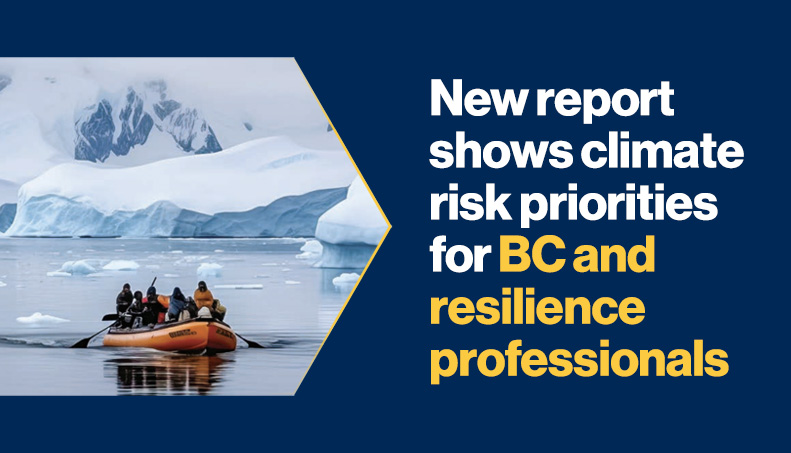New report shows climate risk priorities for BC and resilience professionals

The BCI has launched the BCI Extreme Weather & Climate Change Report 2023, which explores the extent to which organizations are affected by climate-related events as well as how they are planning to mitigate their impact in current and future processes. Sponsored by Conductrr, the report uses survey responses and structured interviews with senior resilience professionals to provide an in-depth analysis of this critical issue.
How are organizations being affected by climate risk?
The BCI Extreme Weather & Climate Change Report 2023 has found that a substantial 44.5% of survey participants have reported a moderate or significant impact from climate-related events during the past five years. However, organizations are still viewing instances of extreme weather as one-off incidents instead of indicators for ongoing and developing climate change. Indeed, organizational preparation for this area seems to be worsening, with 51.1% of respondents stating that their organization does not have a dedicated climate risk budget. This figure is double the 25.1% without a budget in 2022.
When organizations solely allocate resources towards reacting and responding to acute climate-related incidents, it can prevent them from deploying pro-active measures to mitigate the impact of future climate-related events. The extreme weather events that most concern organizations include flooding and rain, with 58.8% considering this to be a top threat, as well as extreme heat/heatwaves (43.9%) and hurricanes & tornadoes (35.2%). The changing climate also means that organizations are having to make adaptions for threats that have never before been seen in their region.
In terms of impact, the report finds that the most frequently experienced disruption from climate-related events is to an organization’s supply chain — a clear increase from fourth place in the list last year — showing how the impacts of severe weather in one region can easily be felt across multiple geographies. This is in line with another finding from the report which suggests that cascading impacts, such as social unrest, are among the most challenging aspects of climate-related events for organizations.
It is therefore positive to see that, of the 50.4% of organizations with an environmental, social, and governance (ESG) proposition, 43.7% have now aligned this to their business continuity plans. This is a significant increase from 2022 and means that organizations can better understand the risks associated with climate change.
Barriers and drivers for change
The significant cost of solutions that can mitigate climate risk, such as upgrading infrastructure, is one of the main barriers to their implementation. For respondents, their organization’s focus on handling short to mid-term risks, instead of considering what could be seen as a more long-term concern, is another factor. Indeed, 27.1% have highlighted the lack of external demands to meet mitigation targets as a barrier to change, highlighting the lack of sufficient binding legislation to enforce climate risk mitigation efforts.
However, the drivers for organizations to put climate risk on the agenda are multi-faceted. Reducing the potential for disruption is a substantial motivator, as expected, but so are the reputational benefits stemming from operating the organization in a sustainable manner. Legislation is also recognised as a driver by 48.5% of respondents but, as with reputational benefits, organizations must be conscious that changes resulting from these motivating factors should be fully embedded within the organization and that there is a genuine commitment to mitigate climate risk within the organization beyond solely meeting the expectations of the market and/or stakeholders.
The role of training and exercising
Despite supply chain disruption being the most frequently experienced outcome of climate-related incidents, it is only exercised by less than 39.7% of participants. The importance of continued training and exercising in relation to disruptions resulting from extreme weather and climate change is critical, but the organization should consider the full range of implications that these disruptions may have. Therefore, it is reassuring to see 72.5% of organizations planning to engage in more training and exercising in this area within the next five years.
Commenting on the report results, Rachael Elliott, Head of Thought Leadership, BCI said:
“This is quite an intriguing report, with some mixed messages. It probably reflects that both organizations and society as a whole are in a state of transition: moving away from the expectation that governments around the world will be able to ‘fix’ the problem by working in harmony towards a realisation that, whatever happens with international agreements in the future, we will probably be faced with rising impacts from a wide range of high-consequence climate-related events. Organizations are moving from keeping a watching brief, to the assessment of probable future impacts, often within the context of ESG programs. The next stage, where few have yet moved to, is the implementation of actual practical climate resilience measures within their own organizations and supply chains.”
Robert Pratten, CEO of Conducttr, added:
“The fight against climate risk is a fight for engagement with the issues. Crisis exercises have the power to emotionally engage participants and hence change behaviour. We're delighted to have supported the BCI's valiant warriors of resilience to share their stories and now hope others gain inspiration for their fight against intransigence!”








